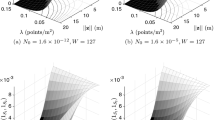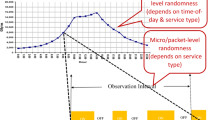Abstract
Intermittently connected mobile networks (ICMNs) serve as an important network model for many critical applications. This paper focuses on a continuous ICMN model where the pair-wise contact process between network nodes follows a homogeneous and independent Poisson process. This ICMN model is known to serve as a good approximation to a class of important ICMNs with mobility models like random waypoint and random direction, so it is widely adopted in the performance study of ICMNs. This paper studies the throughput capacity and delay-throughput tradeoff in the considered ICMNs with Poisson contact process. For the concerned ICMN, we first derive an exact expression of its throughput capacity based on the pairwise contact rate therein and analyze the expected end-to-end packet delay under a routing algorithm that can achieve the throughput capacity. We then explore the inherent tradeoff between delay and throughput and establish a necessary condition for such tradeoff that holds under any routing algorithm in the ICMN. To illustrate the applicability of the theoretical results, case studies are further conducted for the random waypoint and random direction mobility models. Finally, simulation and numerical results are provided to verify our theoretical capacity/delay results and to illustrate our findings.







Similar content being viewed by others
Notes
In this paper, for two functions \(f(n)\) and \(g(n)\), we denote \(f(n)=O(g(n))\) iff there exist positive constants \(c\) and \(n_0\), such that for all \(n\ge n_0\), the inequality \(0\le f(n) \le c g(n)\) is satisfied; \(f(n) = \varOmega (g(n))\) iff \(g(n)=O(f(n)); f(n)=\varTheta (g(n))\) iff both \(f(n)=O(g(n))\) and \(f(n)=\varOmega (g(n))\) are satisfied.
A derangement is a permutation that has no fixed point, i.e., \(\varphi (i)\ne i, i=1,2,\ldots , n\).
Notice that according to (27), the pause time mainly indirectly affects the performance via its impact on the average speed \({\mathbb {E}}\{V^*\}\) in this study.
References
Zhang, Z. (2006). Routing in intermittently connected mobile ad hoc networks and delay tolerant networks: Overview and challenges. Communications Surveys & Tutorials, IEEE, 8(1), 24–37. First Quarter.
Groenevelt, R. (2005). Stochastic models in mobile ad hoc networks. Ph.D. dissertation, Sophia Antipolis, University of Nice, France.
Groenevelt, R., Nain, P., & Koole, G. (2005). The message delay in mobile ad hoc networks. Performance Evaluation, 62(1–4), 210–228.
Zhang, X., Neglia, G., Kurose, J., & Towsley, D. (2007). Performance modeling of epidemic routing. Comput. Netw., 51(10), 2867–2891.
Al Hanbali, A., Nain, P., & Altman, E. (2008). Performance of ad hoc networks with two-hop relay routing and limited packet lifetime (extended version). Performance Evaluation, 65(6), 463–483.
Spyropoulos, T., Psounis, K., & Raghavendra, C. S. (2008). Efficient routing in intermittently connected mobile networks: The single-copy case. IEEE/ACM Transactions on Networking, 16(1), 63–76.
Spyropoulos, T., Psounis, K., & Raghavendra, C. S. (2008). Efficient routing in intermittently connected mobile networks: The multiple-copy case. IEEE/ACM Transactions on Networking, 16(1), 77–90.
Whitbeck, J., Conan, V., & Dias de Amorim, M. (2011). Performance of opportunistic epidemic routing on edge-Markovian dynamic graphs. IEEE Transactions on Communications, 59(5), 1259–1263.
Subramanian, R., & Fekri, F. (2009). Analysis of multiple-unicast throughput in finite-buffer delay-tolerant networks. In Proceedings of IEEE ISIT.
Subramanian, R., Vellambi, B. N., & Fekri, F. (2009). A generalized framework for throughput analysis in sparse mobile networks. In Proceedings of IEEE WiOPT.
Subramanian, R., & Fekri, F. (2012). Queueing models for the performance of multihop routing in a intermittently-connected mobile network. In Proceedings of IEEE ICC.
Goldsmith, A., Effros, M., Koetter, R., Médard, M., Ozdaglar, A., & Zheng, L. (2011). Beyond shannon: The quest for fundamental performance limits of wireless ad hoc networks. IEEE Communications Magazine, 49(5), 195–205.
Neely, M. J., & Modiano, E. (2005). Capacity and delay tradeoffs for ad-hoc mobile networks. IEEE Transactions on Informations Theory, 51(6), 1917–1937.
Grossglauser, M., & Tse, D. N. C. (2002). Mobility increases the capacity of ad hoc wireless networks. IEEE/ACM Transactions on Networking, 10(4), 477–486.
Gamal, A. E., Mammen, J., Prabhakar, B., & Shah, D. (2006). Optimal throughput-delay scaling in wireless networks-part I: The fluid model. IEEE Transactions on Information Theory, 52(6), 2568–2592.
Gamal, A. E., Mammen, J., Prabhakar, B., & Shah, D. (2006). Optimal throughput-delay scaling in wireless networks-part ii: Constant-size packets. IEEE Transactions on Information Theory, 52(11), 5111–5116.
Mammen, J., & Shah, D. (2007). Throughput and delay in random wireless networks with restricted mobility. IEEE Transactions on Information Theory, 53(3), 1108–1116.
Li, P., Fang, Y., Li, J., & Huang, X. (2012). Smooth trade-offs between throughput and delay in mobile ad hoc networks. IEEE Transactions on Mobile Computing, 11(3), 427–438.
Gamal, A. E., Mammen, J., Prabhakar, B., & Shah, D. (2004). Throughput-delay trade-off in wireless networks. In Proceedings of IEEE INFOCOM.
Lin, X., Sharma, G., Mazumdar, R. R., & Shroff, N. B. (2006). Degenerate delay-capacity tradeoffs in ad-hoc networks with brownian mobility. IEEE/ACM Transactions on Networking, 14(SI), 2777–2784.
Sharma, G., Mazumdar, R., & Shroff, N. B. (2007). Delay and capacity trade-offs in mobile ad hoc networks: A global perspective. IEEE/ACM Transactions on Networking, 15(5), 981–992.
Ciullo, D., Martina, V., Garetto, M., & Leonardi, E. (2011). Impact of correlated mobility on delay-throughput performance in mobile ad hoc networks. IEEE/ACM Transactions on Networking, 19(6), 1745–1758.
Bogo, F., & Peserico, E. (2013). Optimal throughput and delay in delay-tolerant networks with ballistic mobility. In Proceedings of ACM MOBICOM, pp. 303–314.
Lu, N., & Shen, X. (2013). Scaling laws for throughput capacity and delay in wireless networks—a survey. IEEE Communications Surveys & Tutorial, 16(2), 642–657.
Urgaonkar, R., & Neely, M. (2011). Network capacity region and minimum energy function for a delay-tolerant mobile ad hoc network. IEEE/ACM Transactions on Networking, 19(4), 1137–1150.
Gao, J., Liu, J., Jiang, X., Takahashi, O., & Shiratori, N. (2013). Throughput capacity of MANETs with group-based scheduling and general transmission range. IEICE Transactions on Communications, E96–B(7), 1791–1802.
Chen, Y., Shen, Y., Jiang, X., & Li, J. (2013). Throughput capacity of aloha manets. In Proceedings of IEEE ICCC.
Kelly, F. P. (2011). Reversibility and stochastic networks. Cambridge: Cambridge University Press.
Bettstetter, C., & Wagner, C. (2002). The spatial node distribution of the random waypoint mobility model. In Proceedings of WMAN.
Nain, P., Towsley, D., Liu, B., & Liu, Z. (2005) Properties of random direction models. In Proceedings of IEEE INFOCOM.
Rhee, I., Shin, M., Hong, S., Lee, K., Kim, S. J., & Chong, S. (2011). On the levy-walk nature of human mobility. IEEE/ACM Transactions on Networking, 19(3), 630–643.
Banerjee, N., Corner, M. D., Towsley, D., & Levine, B. N. (2008) Relays, base stations, and meshes: Enhancing mobile networks with infrastructure. In Proceedings of ACM MobiCom.
Eagle, N., & Pentland, A. (2006). Reality mining: Sensing complex social systems. Personal and Ubiquitous Computing, 10(4), 255–268.
Boldrini, C., Conti, M., & Passarella, A. (2012). Performance modelling of opportunistic forwarding with imprecise knowledge. In Proceedings of IEEE WiOpt. IEEE, pp. 216–223.
Picu, A., & Spyropoulos, T. (2014). DTN-meteo: Forecasting the performance of DTN protocols under heterogeneous mobility. IEEE/ACM Transactions on Networking. doi:10.1109/TNET.2014.2301376
Author information
Authors and Affiliations
Corresponding author
Additional information
This work is partly supported by MEXT.
Rights and permissions
About this article
Cite this article
Chen, Y., Shen, Y., Zhu, J. et al. Capacity and delay-throughput tradeoff in ICMNs with Poisson contact process. Wireless Netw 21, 2453–2466 (2015). https://doi.org/10.1007/s11276-015-0926-z
Published:
Issue Date:
DOI: https://doi.org/10.1007/s11276-015-0926-z




